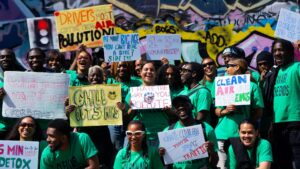Having recently passed committee stage in the House of Lords, unopposed, the Clean Air (Human Rights) Bill is en route to becoming a legally-binding Act. Specialist in environmental and sustainability law at Squire Patton Boggs, Anita Lloyd talks us through what many call Ella’s Law.
(C) Jamie StreetBackground
The Bill would create a human right to breathe clean air, being “air free from certain pollutants or concentrations of pollutants above certain levels”. The Bill also includes requirements for the Secretary of State to achieve clean air across England and Wales within five years of the resulting Act coming into force, and to maintain that status.
The committee stage introduced a slight relaxation of requirements here, so where this duty cannot be achieved for a particular pollutant in a given zone or agglomeration by 1 January 2028 the Secretary of State can postpone the deadline by up to five years (subject to various conditions).
In addition to the obligations on the Secretary of State, the Bill will require bodies including the Civil Aviation Authority, Highways England, Historic England, and Natural England to contribute towards achieving and maintaining clean air. To do so, the Secretary of State will be required to release sufficient funding to these bodies to allow them to fulfil their duties.
Local Authorities would also have a duty to achieve and maintain clean air throughout their area (with equivalent deadlines as are applicable to the Secretary of State). Local Authorities will be required to exercise their powers to improve environmental wellbeing and reduce the publics’ exposure to pollutants. As with the other bodies mentioned in the Bill, the Secretary of State will be required to release sufficient funding to allow Local Authorities to perform their duties.
The Bill would also introduce a new body known as the Citizens’ Commission for Clean Air (CCCA). The CCCA would monitor and enforce the right to breathe clean air in England and Wales. This would include the powers to issue enforcement notices for non-compliance, along with issuing and participating in legal proceedings, such as judicial
review.
CCCA would also be tasked with annually reviewing pollutants against limits included in schedules 1 to 3 of the Bill. In conducting its review, the CCCA would be expected to consider the best scientific knowledge and guidance available. This would mean considering any guidance provided by the World Health Organization (WHO), the UK Health Security Agency, the United Nations Economic Commission for Europe, and advice from scientists on the effects of air pollution on the environment and public health.
WHO limits and guidelines in particular tend to be more stringent than current UK regulations dictate. The CCCA must also apply the precautionary principle in its review. The combined effect of these considerations is likely to result in further tightening of pollution limits, where evidence points to more stringent measures being required to ensure people can breathe clean air.
The Committee on Climate Change also has a role to play: it is tasked with an annual review of the pollutants and the limits listed in Schedule 4 to the Bill, again with specific factors that need to be taken into account.
An amendment to the Bill at committee stage also saw the inclusion of new limit values for PM2.5, the fine particulate matter (10 μg/m3) and nitrogen dioxide (20 μg/m3), both by 1 January 2030, reflecting the latest proposals at EU level. Although comparing the PM2.5 target to the WHO equivalent, this is still twice the WHO limit of 5 μg/m3.
Status and Next Steps
The want and need for greater environmental protections and a human right to clean air is growing on an international scale. In July of this year, the UN General Assembly declared access to a clean and healthy environment as a universal human right. In a press release, UN Secretary-
General, António Guterres stated that “the resolution will help reduce environmental injustices, close protection gaps and empower people, especially those that are in vulnerable situations, including environmental human rights defenders, children, youth, women and indigenous peoples”.
Mr. David Boyd, UN Special Rapporteur on Human Rights and the
Environment, added: “Governments have made promises to clean up the environment and address the climate emergency for decades, but having a right to a healthy environment changes people’s perspective from ‘begging’ to demanding governments to act”.
After passing committee stage, Baroness Jones commented the Bill turns the resolution into “something meaningful”. She also referenced the very recent proposals at EU level for revisions to the bloc’s ambient air quality
directives. Now the Bill has been through committee stage, it will
move to report stage for further scrutiny, before undergoing
its third reading in the House of Lords, and then proceeding
to the House of Commons. There is currently no proposed
timetable for this on the associated web pages.
The most novel feature of the Bill is the new human right to clean air. This will provide further grounds for government and local authority decisions, for example on new infrastructure projects, to be challenged, particularly
by clean air campaigners, but also any individuals or groups of individuals who would be affected by developments and projects with negative impacts on clean air.
We are therefore likely to see increased claims by private individuals and
groups, and there is the potential for more enforcement action, both by and against the various governmental and other bodies listed in the Bill. For example, the Office for Environmental Protection is specifically required in the Bill to exercise its functions so as to ensure the achievement of clean air.
There will no doubt be knock-on effects for companies and individuals responsible for localised air pollution. For example, a recent report found that, despite powers already being available to local authorities to issue fines for smoke pollution in smoke control areas, none have been issued in the past five years; but that could change if Ella’s Law becomes an Act.

















Leave a Reply